Wat is het volgen van middelen en waarom is het essentieel voor het succes van een project?
Onderwerpen zoeken
Voor het succesvol uitvoeren van een project moet je meerdere bewegende delen tegelijkertijd beheren. Je coördineert deadlines, beheert teamleden en houdt alles binnen het budget. Als je hierbij je bronnen niet in het oog houdt, beheer je deze complexe elementen zonder duidelijk inzicht in wat er werkelijk gebeurt.
Het volgen van middelen is het systematische proces van het monitoren en beheren van alle middelen die je team nodig heeft om projecten met succes af te ronden. Dit omvat alles, van de tijd en vaardigheden van teamleden tot budgettoewijzingen en fysieke apparatuur. Het gaat erom te weten wat je hebt, wat je nodig hebt en hoe efficiënt je alles gebruikt dat tot je beschikking staat.
Op deze pagina onderzoeken we wat het volgen van middelen betekent, waarom het cruciaal is voor het succes van projectbeheer en hoe je effectieve volgsystemen kunt implementeren in je eigen projecten.
Wat is het volgen van middelen?
Het volgen van middelen is het monitoren, meten en beheren van alle input die nodig is om je projecten te voltooien. Zie het als het bijhouden van een gedetailleerde voorraad van alles wat je team nodig heeft om te slagen, gecombineerd met een voortdurende monitoring van hoe deze middelen worden gebruikt.
Dit proces omvat meestal het bijhouden van human resources, inclusief de tijd, vaardigheden en beschikbaarheid van teamleden. Het omvat ook financiële middelen, zoals budgetten, uitgaven en kostentoewijzingen.
Fysieke assets, zoals apparatuur, softwarelicenties en workspace, vallen ook onder het volgen van middelen. Zelfs immateriële middelen zoals expertise, kennis en relaties moeten worden gecontroleerd.
Het volgen van middelen past in het grotere geheel van projectbeheer door de gegevensbasis te bieden voor geïnformeerde besluitvorming gedurende de hele levenscyclus van een project. Het houdt rechtstreeks verband met strategische planningsinspanningen, zodat projectplanning zich vertaalt in uitvoering in de echte wereld.
Waarom is het volgen van middelen belangrijk voor effectief projectbeheer?
Het volgen van middelen voorkomt de chaos die het gevolg is van in het duister tasten bij projecten. Als je niet weet hoe je middelen worden gebruikt, krijg je teamleden met een burn-out door al het overwerk terwijl anderen niets doen. Budgetten lopen uit de hand, deadlines worden gemist en de kwaliteit lijdt eronder.
Effectieve software voor het volgen van resources verbetert de efficiëntie door te laten zien waar bronnen worden verspild of onderbenut. Het helpt teamuitputting te voorkomen door te zorgen dat de workloads eerlijk en evenwichtig worden verdeeld. Het belangrijkste is misschien wel dat het bijdraagt aan betere besluitvorming door realtime inzicht te geven in de beschikbaarheid en beperkingen van resources.
Denk bijvoorbeeld aan een app-ontwikkelingsteam dat tegelijkertijd aan meerdere projecten werkt. Zonder het bijhouden van resources kan de projectmanager dezelfde seniorontwikkelaar aan drie verschillende kritieke taken toewijzen, zonder te beseffen dat deze al volledig belast is.
Met het juiste volgsysteem zou de projectmanager onmiddellijk het conflict zien en vervolgens een actieplan kunnen opstellen. Deze zichtbaarheid voorkomt knelpunten, vermindert stress en zorgt ervoor dat projecten soepel verlopen.
Het volgen van resources maakt ook proactief beheer in plaats van reactief beheer mogelijk. In plaats van problemen te ontdekken nadat ze al invloed hebben gehad op deadlines of budgetten, kun je potentiële problemen vroegtijdig herkennen en corrigeren voordat ze grote obstakels worden.
Soorten traceerbare resources
Verschillende soorten resources vereisen verschillende manieren van volgen, maar elk speelt een cruciale rol in het succes van een project. Als je deze categorieën begrijpt, helpt dat ervoor te zorgen dat je geen belangrijke resources mist die het succes van je project kunnen bepalen.
- Menselijke resources: dit omvat de tijd, vaardigheden, beschikbaarheid en workloadcapaciteit van teamleden. Slecht beheer van menselijke resources leidt tot de meest voorkomende mislukkingen van projecten, wat vaak resulteert in gemiste deadlines door overbelaste teamleden of vaardigheidstekorten die niet tijdig werden vastgesteld.
- Tijdresources: naast de gewerkte uren omvat dit ook projecttijdlijnen, deadlines van mijlpalen en het kritieke pad binnen je project. Tijd is vaak de meest beperkte resource, waardoor het bijhouden ervan essentieel is voor jaarlijkse planning.
- Financiële resources: dit omvat budgettoewijzingen, werkelijke uitgaven, kostenprognoses en berekeningen van het rendement op de investering. Wanbeheer van financiële resources kan fataal zijn voor projecten, zelfs als al het andere goed gaat. Daarom is het volgen ervan cruciaal voor de duurzaamheid op lange termijn.
- Fysieke en digitale assets: dit omvat alle apparatuur, softwarelicenties, workspaces en tools. Deze resources hebben vaak afhankelijkheden en beperkingen die onverwachte knelpunten kunnen veroorzaken als ze niet goed worden bijgehouden en beheerd.
5 stappen voor het volgen van resources om projecten effectief te beheren
Het volgen van resources voor succesvol projectmanagement volgt een systematische aanpak die transparantie, verantwoordelijkheid en efficiëntie in je workflow inbouwt. De sleutel is om eenvoud te behouden en tegelijkertijd de volledigheid te garanderen. Je wilt een volgmethode die de productiviteit van je team helpt in plaats van belemmert.
De beste systemen voor het volgen van resources automatiseren de gegevensverzameling waar mogelijk, terwijl het menselijke element gefocust blijft op analyse en besluitvorming. Ze blijven ook gebruiksvriendelijk, zodat teamleden gemakkelijk gegevens kunnen invoeren en toegang hebben tot de informatie die ze nodig hebben, zonder moeite.
1. Identificeer alle belangrijke resources
Breng alle resources in kaart die je project nodig heeft, inclusief zowel de voor de hand liggende als de verborgen afhankelijkheden. De directe resources omvatten teamleden, budget en apparatuur. De indirecte resources blijken vaak net zo cruciaal: gedeelde diensten, externe leveranciers, goedkeuringsprocessen en institutionele kennis die door specifieke personen wordt beheerd.
Maak een inventaris van resources aan die beschikbaarheidsbeperkingen, afhankelijkheden en speciale vereisten omvat. Voeg ook resources toe die later in de levenscyclus van het project nodig kunnen zijn.
2. Stel specifieke KPI's vast om de voortgang te volgen en hiaten te identificeren
Stel meetbare statistieken vast die de huidige prestaties en potentiële problemen onthullen voordat ze kritiek worden. Focus op sleutelindicatoren die zowel operationele als strategische inzichten bieden, zoals:
- Bezettingsgraad: meet hoeveel van de beschikbare capaciteit wordt gebruikt en helpt bij het identificeren van overbelasting en onderbenutting.
- Capaciteit versus vraag: vergelijkt de beschikbaarheid van resources met de projectvereisten om potentiële tekorten vroegtijdig op te sporen.
- Kostenverschil: houdt de werkelijke uitgaven bij ten opzichte van de begrote bedragen om financiële controle te behouden.
- Resource-efficiëntie: meet de output per eenheid van resource-input om de productiviteit te optimaliseren.
- Doorlooptijd voor resourceverwerving: houdt de tijd bij die nodig is om de vereiste resources te verkrijgen wanneer er tekorten worden vastgesteld.
3. Kies een volgsysteem
Gebruik gecentraliseerde digitale tools in plaats van handmatige spreadsheets of losgekoppelde systemen. Spreadsheets worden onhandig en vatbaar voor fouten naarmate projecten complexer worden.
Zoek naar software voor het volgen van resources die kan worden geïntegreerd met bestaande projectbeheertools en die realtime inzicht biedt in alle soorten resources.
4. Stem het volgen af op de projectmijlpalen
Synchroniseer het volgen van resources met projecttijdlijnen en de belangrijkste deliverables om ervoor te zorgen dat het volgen voldoet aan de werkelijke projectbehoeften. Deze afstemming maakt resourcegegevens beter bruikbaar.
Plan regelmatige beoordelingen van de toewijzing van resources bij elke belangrijke mijlpaal en gebruik deze controlepunten om plannen aan te passen op basis van prestaties. Deze aanpak ondersteunt zowel activiteiten op het gebied van resource- als capaciteitsplanning.
5. Evalueer het gebruik van resources en pas dit waar nodig aan
Voer periodieke evaluaties uit om de prestaties van resources te beoordelen en plannen aan te passen op basis van nieuwe inzichten. Focus op continue verbetering door middel van regelmatige aanpassingscycli.
Gebruik prestatiegegevens om toekomstige beslissingen over resourceplanning te onderbouwen en patronen te identificeren die de inschattingsnauwkeurigheid verbeteren.
Veelvoorkomende uitdagingen bij het volgen van resources
Zelfs goedbedoelde inspanningen voor het bijhouden van resources kunnen door voorspelbare obstakels in de weg gezeten worden die hun effectiviteit ondermijnen. Door deze uitdagingen te begrijpen, kun je oplossingen voorbereiden voordat er problemen ontstaan.
- Onnauwkeurige of onvolledige gegevens: teamleden kunnen vergeten hun tijd te registreren, schattingen verkeerd maken of het bijwerken van informatie over het gebruik van resources overslaan. Pak dit aan door het invoeren van gegevens zo eenvoudig mogelijk te maken, duidelijke richtlijnen te geven over wat moet worden bijgehouden en te laten zien hoe nauwkeurige gegevens het team direct ten goede komen via verbeterde projectresultaten.
- Weerstand tegen volgtools: sommige teamleden beschouwen het volgen van resources als microbeheer of administratieve ballast. Pak dit aan door teamleden te betrekken bij het selectieproces van de tools, de nadruk te leggen op de voordelen in plaats van de vereisten, en ervoor te zorgen dat de volgsystemen ook waarde opleveren voor individuele teamleden door betere zichtbaarheid van de werkdruk en planning.
- Te ingewikkelde systemen: complexe volgvereisten kunnen meer problemen veroorzaken dan ze oplossen, wat leidt tot slechte implementatie en onnauwkeurige gegevens. Blijf je concentreren op essentiële statistieken die de besluitvorming rechtstreeks ondersteunen in plaats van te proberen al het mogelijke te meten.
De beste tools en sjablonen voor het volgen van resources om het succes van projecten te versnellen
Met de juiste tools en sjablonen kan het volgen van resources veranderen van een vervelende administratieve taak in een strategisch voordeel dat het succes van projecten bevordert. Hier zijn de meest effectieve opties voor verschillende aspecten van resourcebeheer.
1. Jira: geschikt voor resourcebeheer in verschillende teams
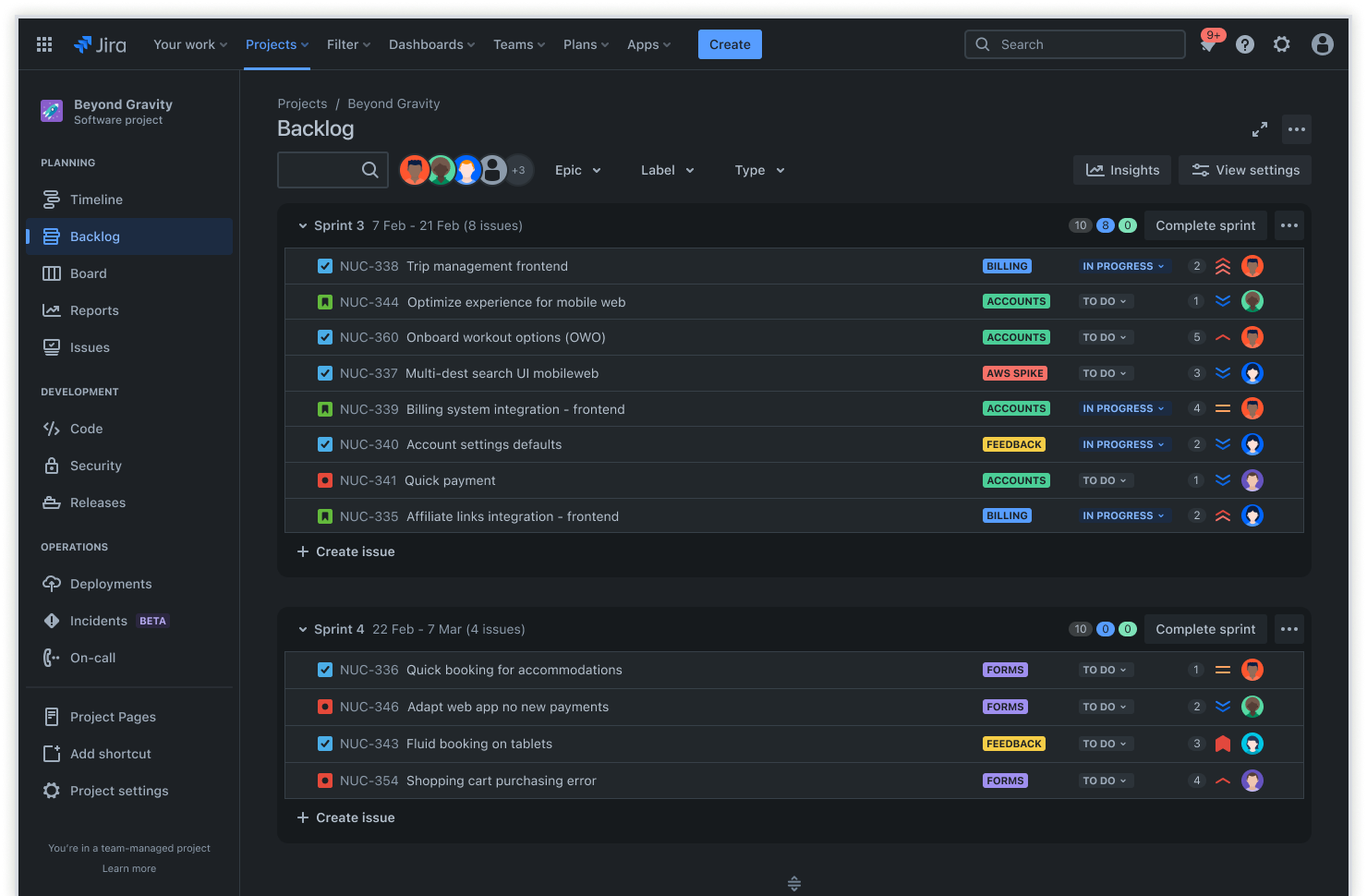
Jira blinkt uit in het volgen van resources omdat het naadloos integreert met bestaande projectworkflows en tegelijkertijd krachtige rapportage- en visualisatiemogelijkheden biedt. Teams kunnen de tijd bijhouden, de voortgang vergelijken met de capaciteit, en realtime inzicht krijgen in de toewijzing van resources over meerdere projecten tegelijk.
Dankzij de integratiemogelijkheden van het platform kan het volgen van resources rechtstreeks worden gekoppeld aan de workflows voor projectbeheer, waardoor dubbele gegevensinvoer wordt voorkomen en ervoor wordt gezorgd dat informatie actueel blijft. De bord- en backlogweergaven van Jira bieden verschillende perspectieven op de toewijzing van resources, terwijl de rapportagefuncties trends en optimalisatiemogelijkheden identificeren.
2. De Jira-sjabloon voor het volgen van projecten: vooral geschikt voor het bijhouden van resources op projectniveau
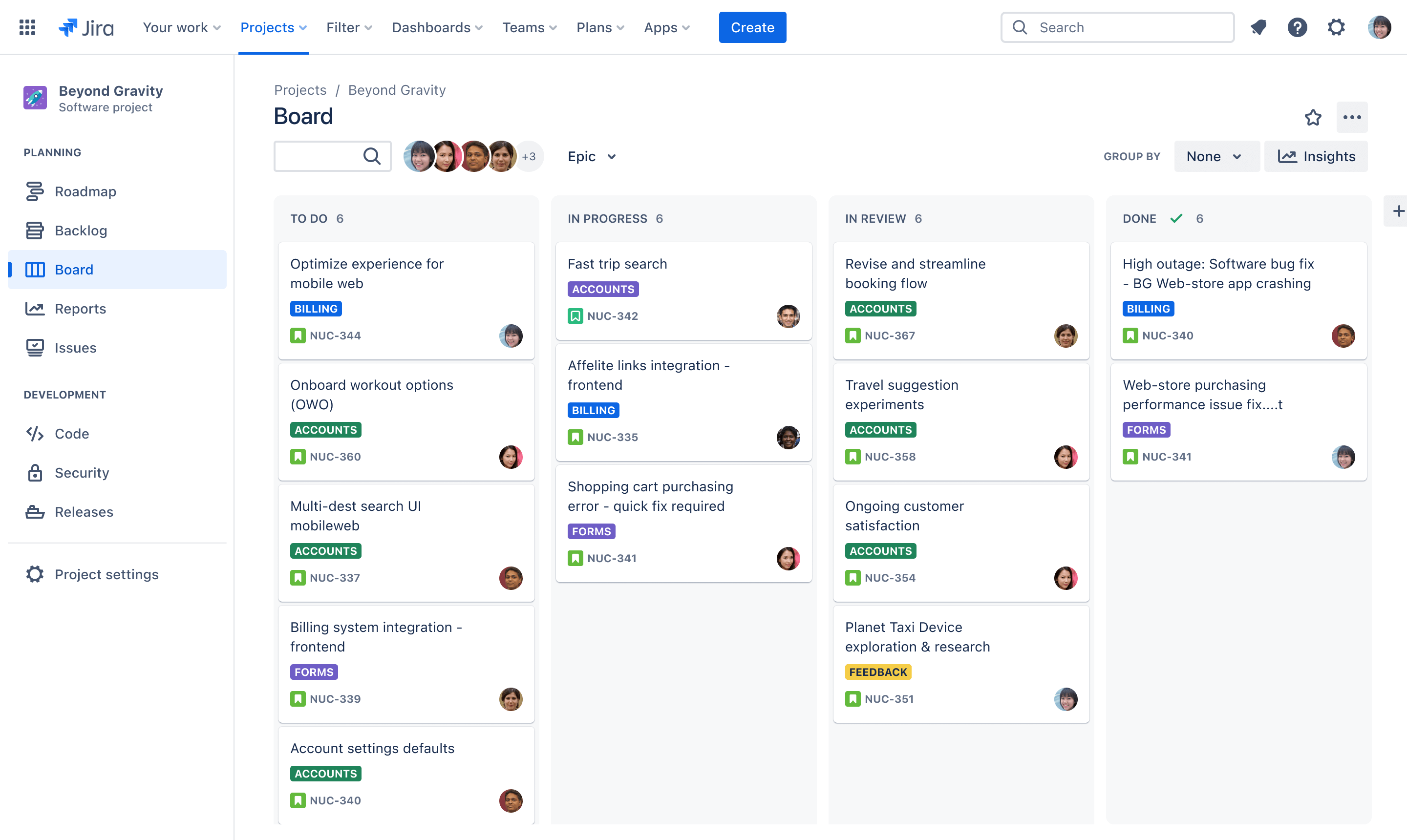
Het sjabloon voor het volgen van projecten biedt een gestructureerde aanpak voor het monitoren van alle resources binnen een specifieke projectcontext. Het bevat vooraf geconfigureerde velden voor verschillende soorten resources, geautomatiseerde berekeningen voor belangrijke statistieken en aanpasbare dashboards met zowel gedetailleerde als samenvattende overzichten van het gebruik van resources.
3. De Confluence-sjabloon voor resourceplanning: geschikt voor het organiseren en toewijzen van resources
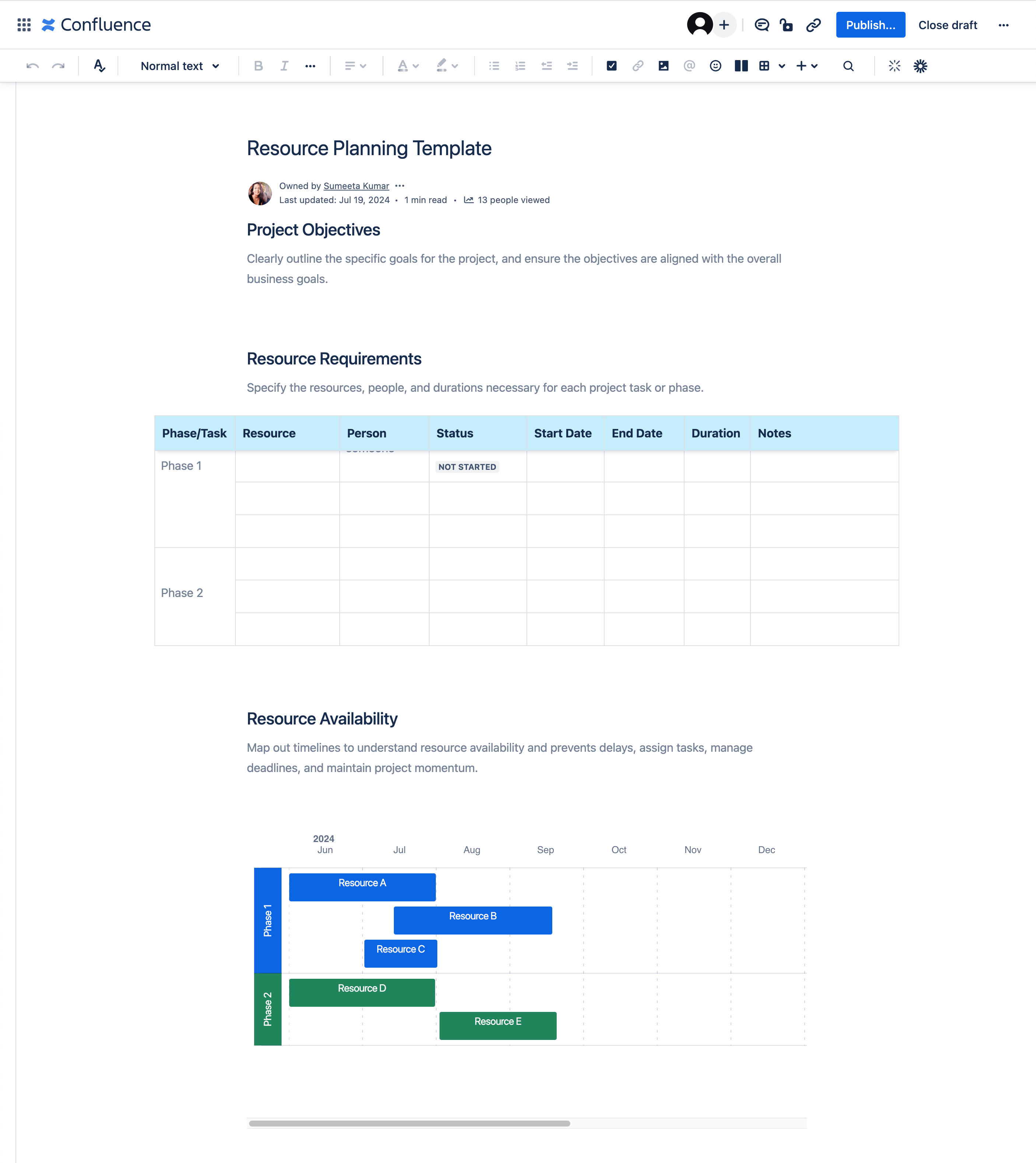
De sjabloon voor resourceplanning is perfect voor de planningsfase van het volgen van resources. De sjabloon helpt teams om de vereisten voor resources te documenteren, afhankelijkheden in kaart te brengen en toewijzingsplannen aan te maken die eenvoudig kunnen worden gedeeld en bijgewerkt. De sjabloon koppelt planningsactiviteiten rechtstreeks aan de uitvoering door integratie met Jira.
4. Jira Product Discovery: geschikt voor prioritering op basis van de capaciteit van het team
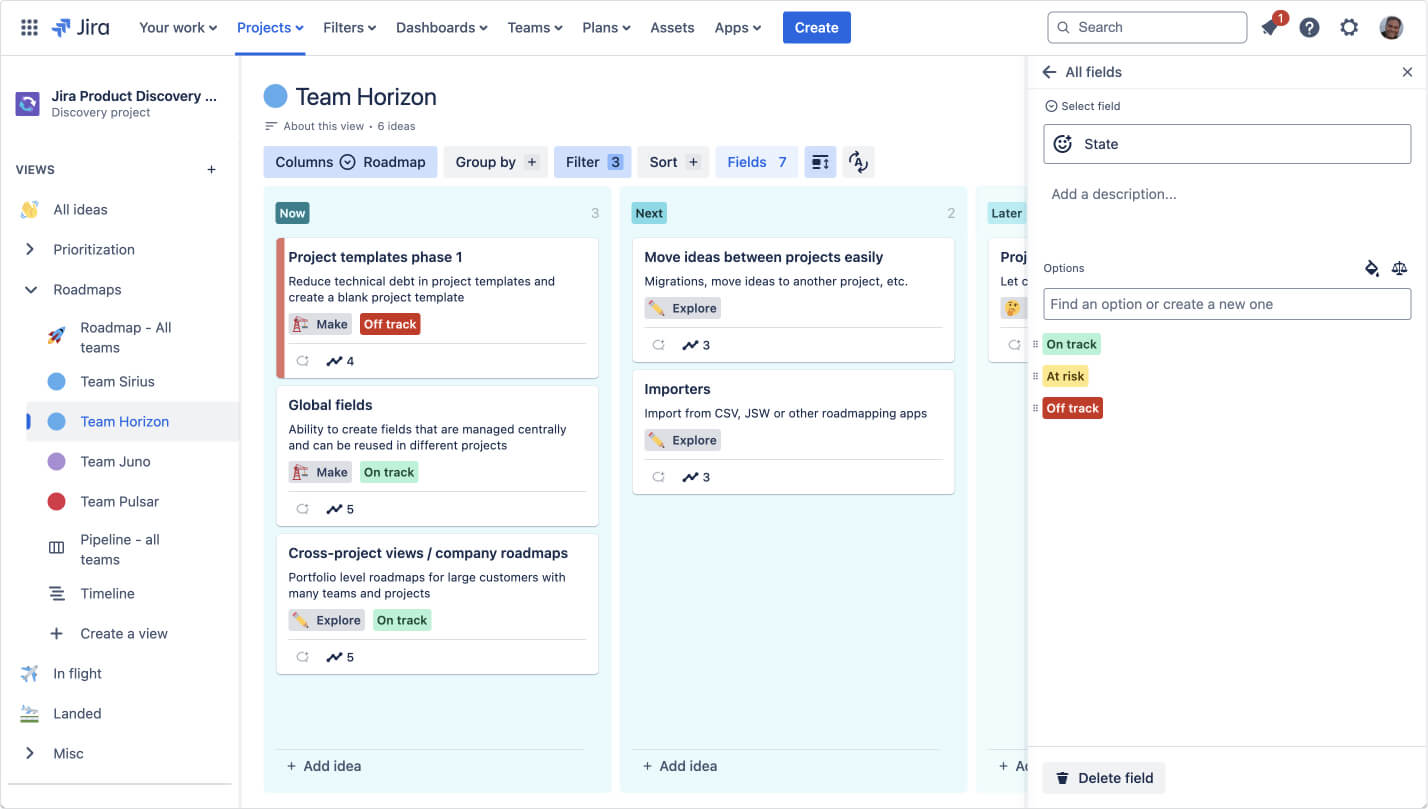
Deze tool helpt teams om doelen te stellen door naast zakelijke prioriteiten rekening te houden met resourcebeperkingen. De tool geeft inzicht in de capaciteit van het team en helpt bij het prioriteren van werk op basis van beschikbare resources in plaats van alleen op basis van zakelijke waarde.
5. Confluence-sjabloon voor capaciteitsplanning: geschikt voor het visualiseren van de capaciteit van het team
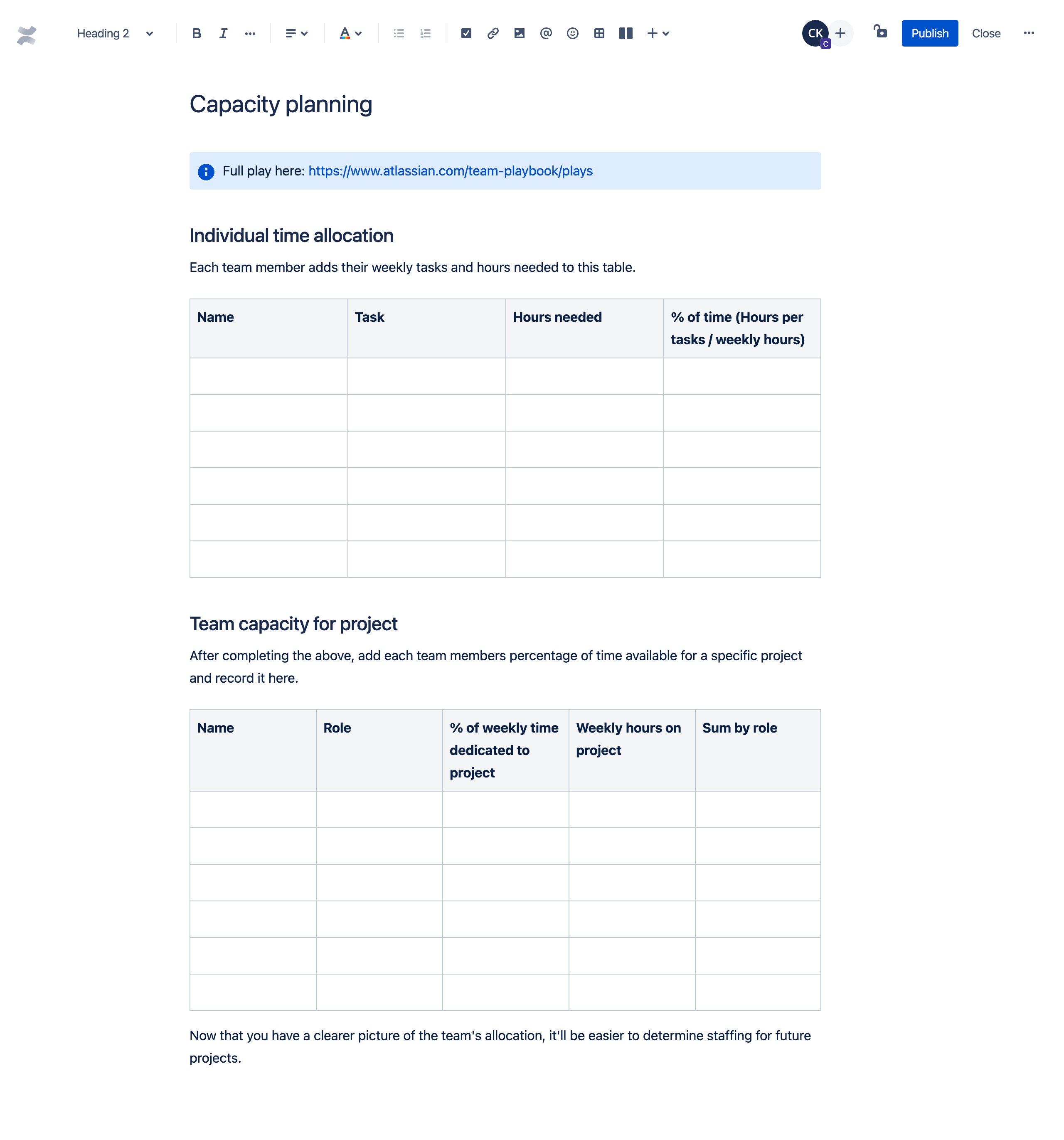
De sjabloon voor capaciteitsplanning biedt duidelijke visuele representaties van de beschikbaarheid van teams en de verdeling van de workload. Capaciteitsplanning helpt overbetrokkenheid te voorkomen en tegelijkertijd mogelijkheden te identificeren om de beschikbare resources beter te benutten.
Aan de slag met het bijhouden van resources in Jira

Jira biedt uitgebreide mogelijkheden voor het volgen van resources die moderne teams nodig hebben, zonder onnodige complexiteit. De bordweergave geeft je visueel inzicht in de werkverdeling over teamleden, terwijl de backlogweergave je helpt bij het plannen van de toewijzing van resources voor aankomend werk.
Door Jira te koppelen aan Confluence en Jira Product Discovery, creëer je een uitgebreid ecosysteem voor het volgen van resources dat de volledige levenscyclus van een project ondersteunt, van de initiële planning tot de uitvoering en analyse van het project. De integratie met Confluence zorgt voor een naadloze verbinding tussen documentatie voor resourceplanning en de daadwerkelijke uitvoering van het project, terwijl Jira Product Discovery helpt ervoor te zorgen dat de toewijzing van resources wordt afgestemd op strategische prioriteiten.